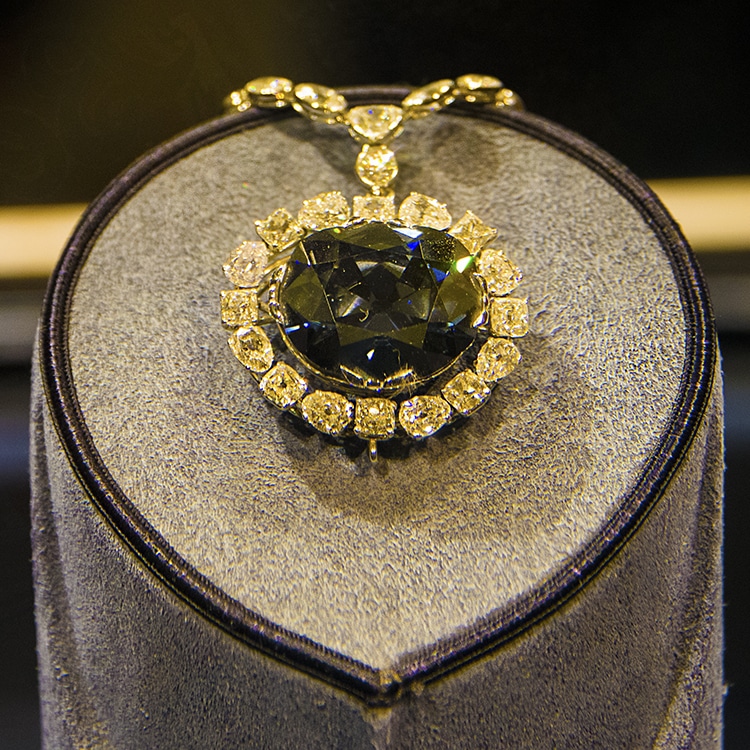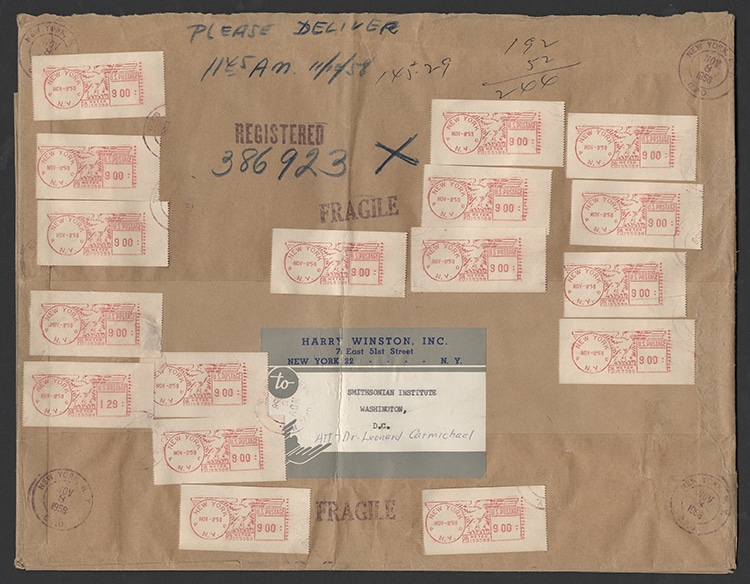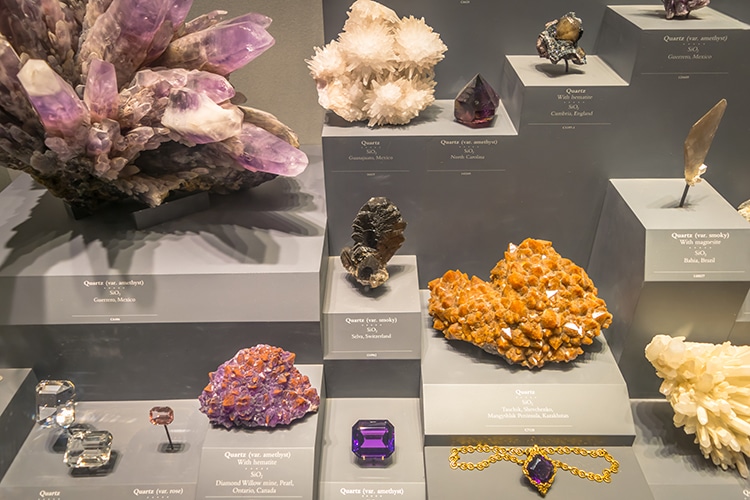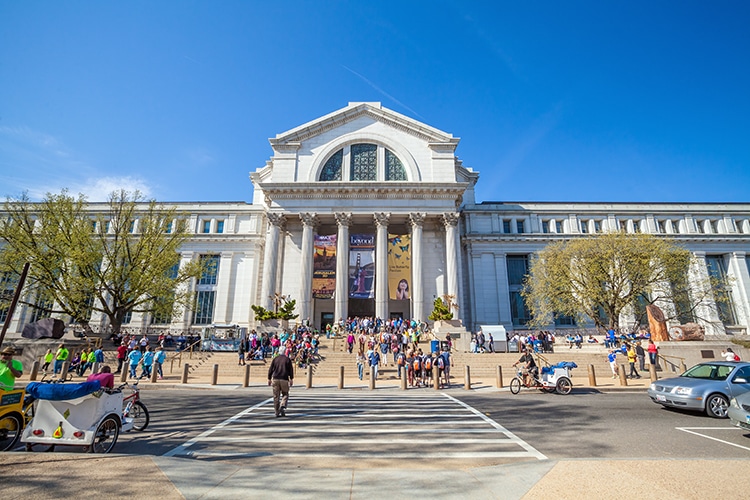The Hope Diamond in its current setting.
However, it is a rare blue diamond once worn by royalty and the filthy rich.
Read on to discover the twisted tale of the world’s most fascinating gem.

The Hope Diamond in its current setting. (Photo: Mbalotia viaWikimedia Commons,CC BY-SA 3.0)
What is the Hope Diamond?
The Hope Diamond illuminated and without a setting.
(Photo: 350z33 viaWikimedia Commons,CC BY-SA 3.0)
TheHope Diamondis a rare, colorful gemstone.

The Hope Diamond illuminated and without a setting. (Photo: 350z33 viaWikimedia Commons,CC BY-SA 3.0)
It is an example of a fancy color diamond, specifically a blue diamond.
The blue color comes from traces of boron within the famously hard crystalline lattice of the diamond.
Blue diamonds can vary in shade.

Left: 17th-century sketch by Jean-Baptiste Tavernier of the Tavernier Blue. (Photo:Wikimedia Commons, Public domain) | Right: A 2008 gouache of the 18th-century Golden Fleece of King Louis XV of France, painted by Pascal Monney. The French Blue diamond is seen in the piece. (Photo: Francoisfarges viaWikimedia Commons,CC BY 3.0)
The Hope Diamond is described as fancy dark grayish-blue.
The stone is (at present) cut in a cushion antique brilliant-cut with extra facets.
The deep blue of the stone hides some strange properties.

Evalyn Walsh McLean (1886-1947), wearing the Hope Diamond circa 1914. (Photo:Library of Congress Prints and Photographs Division)
Under ultraviolet light, a blue diamond emits a blue glow.
However, the Hope Diamond glows red.
Thisunique phosphorescent signatureindicates trace nitrogen among the boron and carbon.

The Hope Diamond mailing wrapper in which Harry Winston sent the diamond to the museum. (Photo:National Postal Museum Collection)
This special mix formed into a stone over a billion years ago under Earth’s surface.
Today, it is set in a necklace.
The blue stone is surrounded by 16 white diamonds and its chain contains 45 more stones.

Photo:Stock Photosfrom KEITH J. FINKS/Shutterstock
Tavernier and the French Royal House
Left: 17th-century sketch by Jean-Baptiste Tavernier of the Tavernier Blue.
The French Blue diamond is seen in the piece.
In 1666, aFrench gem dealertraveling to India purchased a large, rough-cut blue diamond weighing 112 carats.

Photo:Stock Photosfrom F11PHOTO/Shutterstock
The merchant, Jean Baptiste Tavernier, returned to France with what became known as the Tavernier Blue.
A diamond so magnificent deserved a royal setting.
It was worn by the king as a pendant on a ribbon necklace.
The stone took the epithet Blue Diamond of the Crown or the French Blue.
In the 18th century, the diamond was reset in an elaborate pendant with other stones.
The pendant was an honorific to be worn representing the Order of the Golden Fleece.
The French Revolution toppled theAncien Regime.
With the fall of the royal family, many of their treasures were looted.
In September of 1792, the diamond vanished.
It made its way to England and may have been owned by King George IV.
It reappears in records of the London diamond dealer Daniel Eliason in 1812.
The diamond has been significantly downsized and recut to its present-day weight.
By 1839, the diamond was owned by Henry Philip Hope, a banking heir who died that year.
The diamond then passed through the Hope family over the decades until its subsequent sale in 1901.
By 1909, it had been sold again and was set to be auctioned in Paris.
Newspapers enjoyed publishing stories highlighting the misfortunes of past ownersreal, exaggerated, and imagined.
The ex-wife of the final Hope to own the jewel blamed it for her failed marriage.
Others blamed the jewel for the beheadings of the last French monarchs.
However, some owners such as Tavernier himself lived to ripe old ages.
The Hope Diamond was already a legend of its own.
This legend may have appealed to Mrs. McLean, who did eventually pay for the diamond.
She is responsible for its current white diamond setting.
There is a small clasp below the gem for hanging additional pendants from her collection.
She owned the diamond until her death at age 60 in 1947.
Harry Winston, the famous jeweler, bought the lot.
The Hope Diamond became a central attraction in a traveling jewel exhibit run by Harry Winston.
The diamond, however, was soon destined for a new home.Dr.
The story goes that he convinced Harry Winston to donate the jewel to the museum.
The jeweler made a patriotic gesture and contributed the gem to help found the gemcollection seen today.
The Hope Diamond mailing wrapper in which Harry Winston sent the diamond to the museum.
Today thebrown paper wrapperwith postage is on display at the National Postal Museum.
According to theSmithsonian, The Hope diamond has left the Smithsonian only four times since it was donated.
In 1962, the diamond was exhibited at the Louvre in Paris.
Today, the Hope Diamond is one of the Smithsonian National Museum of Natural History’s most popular attractions.
The mineral and gemstone galleries are a festival of color and dancing light refracted through precious stones.